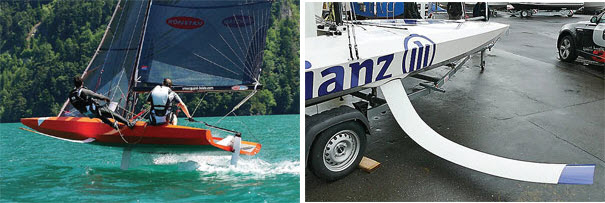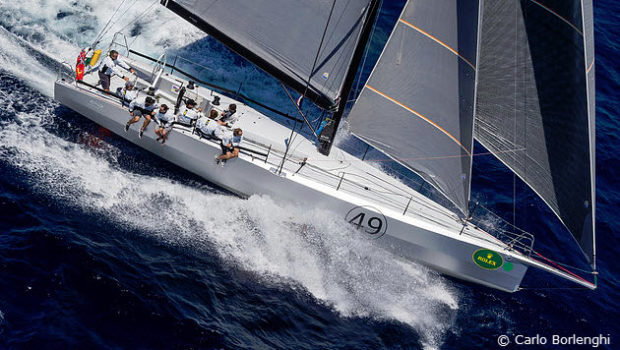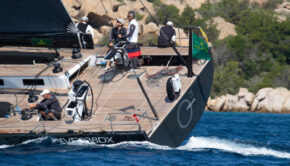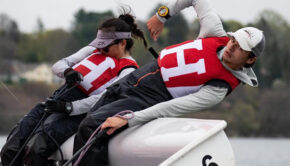Foiling in the Monohull Stream
Published on February 20th, 2017
Something that seemed ‘out there’ just a few years ago is now making its way firmly into the mainstream. It is also winning yacht races. In the March issue of Seahorse magazine, Gordon Kay has an update on DSS state of the art.
With the monohull world increasingly embracing foils it seems timely to reflect on some of the lessons learnt over the past year and how 2017 and beyond look for the impact of DSS and for the other foil solutions in the 2017 marketplace..
While dramatic footage of semi-flying or flying yachts gets the headlines it is the background story that is perhaps more significant. In 15 years of developing, engineering and supplying DSS foils and installing them on various yachts we have never had a failure beyond the cracking of one foil, quickly identified as a failure by the builder to build the hull exit bearing surface as drawn. It is therefore quite thought-provoking to see the failure level in some other avenues of foil development.
The problems suffered by the Imoca class, particularly in testing, have been significant, not limited to foils in the water but to the windward foil as well (echoing issues the big tris experienced when ‘over-stiff’ ama construction led to failures through wave impact on the windward float).
(There have also, in passing, been a great many – unpublicised – foil failures during testing for this year’s 35th America’s Cup. However, this is a different situation where lightweight constructions are consciously being explored and tested to the ultimate limit. Still, it does confirm that this is a complex area of development when the best engineers and designers in yacht racing still have to place more than a little reliance upon good old trial and error.)
Safety and reliability have always been the watchwords in our development of foils at DSS. If it was not going to work reliably or safely then we could not see the point of investing heavily in R&D and practical testing. It will not always be possible to get a client to write endless cheques to cover ‘development’, or if it is then the class will go the way of the Orma 60s and others.
So we stand at a key point in the development of foils within the industry; it is no longer the preserve of the lunatic fringe, and it is crucial that future development needs to prioritise safety and reliability.
Modern history
2016 began with the Welbourn-designed DSS Quant 23 winning its division in the European Yacht of the Year awards. The first fully flying keelboat for production, and designed to be very much the everyman design that would allow a new generation, young and less young, to fly in safety and without the need to swim if it all went wrong.

Hugh Welbourn’s flying scow, the Quant 23, uses a curved foil to achieve essentially the same lift effect as is enjoyed on the Infiniti 46 with its straight DSS foils. However, in the case of the Quant the result is full flight in just 8-10kt of breeze. Compared with the Imocas, the Quant benefits from a keel fin to resist leeway, dispensing with the Imoca’s large foil tips. But the similarities, especially between the little foiler and Hugo Boss, are evident. Yet there is still a huge amount to learn, particularly in solving the Imoca puzzle with its rule constraints. Hugo Boss’s 24-hour record was, ultimately, only 2nm better than François Gabart managed four years ago without any foils at all…
To date 10 Quant 23s have been sold, and with the original Q23 now on Lake Garda and available for all to try, more and more people have seen what is available without spending a king’s ransom and requiring America’s Cup levels of skill.
The launch of the Infiniti 46 offshore racer, again Welbourn designed, caused a few raised eyebrows and comments when she first arrived in Europe in May, particularly with respect to the ability of such a boat to sail to its IRC rating.
Class wins and podiums in the Rolex Middle Sea Race and then the RORC Transatlantic Race, all with a Corinthian crew, demonstrate that perhaps the rating office might have been closer to the mark than the armchair experts.
What has been more interesting has been the amount learnt in the 10,000 miles of sailing in 2016 that the first Infiniti 46 has now completed. Zero structural failures, zero foil issues, zero issues with foil exits and, interestingly, zero UFO strikes…
We have always built our foils with Dom Pedron of Isotop and to date they have all been engineered by either Gurit or Will Brooks and, so far, they have all performed to expectation.
An interesting fact taken from the Infiniti 46 is that while the displacement of the yacht is 5,500kg, the foil exits are engineered for 9,500kg of load. Conservative? Probably, but avoiding failure as far as one can through a little extra diligence just seems smarter than saving a gram or two, with the consequential risks, as seen with some of the failures in the Imoca 60 fleet.
Another interesting launch was the prototype FLO1 from Aeronamics. A dinghy that flies but is not a Moth, and as with the Q23 is designed to introduce the averagely capably sailor to an easier and safer flying experience.
As 2016 drew to a close two larger projects emerged. First the CQS, Ludde Ingvall’s inspired reincarnation of his previous yacht, expertly handled by Brett Bakewell-White and launched a few weeks before the Rolex Sydney Hobart Race – making it to the startline against all the odds. That process was bittersweet for us, as the DSS foil itself, built in Vietnam, failed early in the race, having shown glimpses of the performances we have come to expect; with just a few days of sailing with the foil prior to the race there is much to learn. 2017 will no doubt be an interesting year of development for this team, with an all-new boat also in the air…
Finally, we completed our collaboration with Farr Yacht Design on the creation of a new 40m+ fast-cruiser that is now under construction. The process of due diligence took over six months with exhaustive studies of various foil geometries – necessarily in conjunction with different interior layouts. Details are still under wraps but we expect this yacht to demonstrate the same strong performance relative to its conventional peers as the Infiniti 46.
In terms of market appeal, according to our clients not everyone prefers the final designs from a previous generation.
And ratings…
The rating story persisted throughout 2016 and into 2017, which will also see updated ratings for retrofits such as the Reichel-Pugh 60 Wild Joe. Faced with the challenge of a single-figure rating for allcomers, IRC have given a great deal of thought to how best to address DSS when rating the boats. Clearly, when executed intelligently, like most yacht designs, these boats can sail to their rating; what has been identified as undesirable is fitting foils that are not particularly effective or have a limited range and then asking IRC or ORC for a rating credit to ‘help’.
There are no rating credits for poorly designed rudders or keels so the same should apply to the foils and how they make up the overall balance and performance of a yacht.
We have conducted many studies internally and with both Farr Yacht Design and Brett Bakewell-White, plus comparison routeings with navigator Ian Moore, and while there is no silver bullet it is clear you can no longer dismiss DSS when you are considering an offshore/coastal programme, be it ORC or IRC focused.
We continue to work closely with the rating authorities, with both poacher and gamekeeper reasonable bedfellows as we look to provide confidence for owners who wish to move forward, while the rating managers ensure that their current fleets remain competitive… (Strangely the best sailed and prepared boats still seem to do well regardless of configuration).
2017 will bring more DSS ratings to the fore and so more performance data with which to validate the rating numbers.
Imoca 60s
Bittersweet also best describes our experience within this class so far and this is where a history lesson is perhaps appropriate. In 2008 Hugh Welbourn and DSS were approached by Alex Thomson Racing to look at the possibility of collaborating with Finot-Conq in incorporating DSS into a new design for the next Vendée cycle. The base boat was not suitable so we declined; an opportunity missed.

Vendée Globe yacht design… in a nutshell. Five of the latest-generation Imoca 60s, including Banque Populaire (left), were committed to similar VPLP/Verdier designs when Alex Thomson (shrewdly) pressed the button with the sixth… Hugo Boss (right). Thomson’s boat used a simpler, more DSS style of horizontal foil than her foiled rivals; but as significant is that with extra dynamic righting moment his team ‘risked’ a slightly narrower hull – which contributed to some devastating pace downwind and in light air. Thomson powered away from the fleet on the opening leg, at times sailing 2-3kt faster
However, work on other Open 60 proposals led us towards slimmer, lighter design concepts using DSS as the starting point, which in hindsight may well have turned a well-established fleet on its head. At the same time we opened discussions with the Imoca class, and eventually DSS did end up being accepted… but with an expensive sting in the tail.
A single transverse ‘traditional’ DSS foil would be counted by Imoca as two of five allowable moveable appendages; assuming a traditional wide hull requiring twinrudders, plus canting keel, then any foil solution would now need to deliver dynamic lift and increased righting moment (RM) plus enough sideforce to resist leeway.
In the end a complex hybrid solution with an assortment of vertical tips became the norm for the most recent VPLP/Verdier designs, but these brought into focus the risks – and costs – of introducing complex angled sections into highly loaded composite boards (a pair of typical Dali foils will set you back €300,000–350,000 plus).
Effectively then, these boats had put their eggs very much in one basket – side force and RM all combined in one item, with the failure risk increased with the tip additions. Hit something with a relatively straight, flattish foil and the shock loads fore-and-aft can be designed for… hit something just with one of those long tips and suddenly you are also dealing with torque loads on the inner foil and cassette that are much harder to resolve accurately.
Not surprisingly, the phonecall came in from ATR early in 2014. One of their in-house technicians had been working with Infiniti Yachts on a 30m project for Danish Yachts before joining ATR and had had plenty of sea time on the Infiniti 36 and our 27ft test boat and so was well informed as to DSS and its potential.
‘What are your thoughts on a DSS-type 60 to the current Imoca rules…’ So Hugh ran some comparisons which demonstrated that, executed properly, significant gains could be made over both the existing fleet and the new designs we were then aware of. Hugh and Will Brooks developed several design options, which to our eye looked normal but in the context of superwide Imoca 60 world the boats did look quite radical! We then provided ATR with some basic lines and a couple of appendage configurations which went into the Qinetiq tank for evaluation; soon afterwards we learned that ATR had opted to sign an agreement with VPLP for their new boat.
However, the story did not quite end there. ATR asked: ‘Would we collaborate with VPLP?’
So we arranged to take VPLP sailing and ATR chartered the first Infiniti 36 for a number of months. We arranged further tests with the ATR team on DSS boats and generally headed in the right direction. Sadly, while all was well during the sailing trials, back on land matters of exclusivity between DSS and ATR started to creep in and ultimately the working relationship ended. However, the information and thoughts that we had already shared could hardly be unlearnt, but clearly we had done enough to convince them that foils were the way forward.
If nothing else, even with some of the starboard foil broken off, Hugo Boss did at least prove to be the fastest Imoca 60 in the Vendée Globe. Encouragingly for us, the boat that Alex took around the world was also indeed narrower and lighter than the similar but not identical new boats of his French rivals, moving closer to the design tested at Qinetiq.
The Vendée design directions are very clear – the race is usually decided on the run down the Atlantic and being first boat into the Southern Ocean systems. Ice limits then corral the boats into narrow strategic options riding the weather systems around the bottom, and finally around the Horn after which it is a case of protecting your position – far from easy when passing through the Doldrums and dealing with the complex weather on this final stage of the course. So the slimmer, lighter, more easily driven option scores heavily here on the Vendée course matrix – add in the pace from fully utilising foils in the design and it’s a no-brainer. Or at least it should be.
Whether through lack of insight and/or just a lack of confidence in a new technology, or simply timing, the other five new Imoca 60s all featured ‘standard’ fatter hulls with added Dali foils of varying configurations, that could revert to standard configuration if the experiment failed.
Although they are quicker than the previous non-foil generation, the speed of the slightly slimmer Hugo Boss implies that five very expensive recently built yachts may already be past their prime. It would also have been interesting to see PRB’s time without her own keel problems.
The technical conclusion seemed clear. With two foils Hugo Boss was demon – strably quicker than any other yacht in the class; in particular the undesirable ‘crashing and about to crash’ operating mode of the Dali is softened, with a DSS-style foil plus narrower hull making for higher sustainable average speeds.
As the 2016/2017 Vendée Globe reached its conclusion it was interesting to read in Seahorse that some Imoca designers are already thinking about the next generation of narrower designs, something we have been doing for some years.
Nor, it seems, has the DSS effect been lost on the wider market as we already have interest in new designs to move the game forward again in the Imoca class.
Anything but DSS?
As we move from the lunatic fringe into the mainstream DSS is increasingly being accepted. We have technical partnerships, licensing agreements and design arrangements with companies building boats from 4.5m to 40m plus. Farr Yacht Design, McConaghy Boats, Seair, Mer Forte, Bertrand Design, Infiniti Yachts, Quant Boats, Brett Bakewell-White, Aeronamics, Baltic Yachts and a few others we cannot talk about are proving the appeal of DSS across a wide spectrum.
The price of the DSS licence fee is oft discussed but we feel it is fair, particularly when one considers it is a one-off cost that equates to a couple of sails. For an Imoca 60 at the time we were in discussions the licence was €50,000. The cost for one set of Dali foils was, as mentioned, up to €350,000, then you break a few, develop a few and before long it is almost real money. The complete package for the DSS retrofit of the 60ft Wild Joe, including all costs is significantly less than half that of one set of Dali foils… in a new build it would be even less.
Does DSS really work? DSS foils have been proving themselves for some years now and continue to do so. Whether you want an IRC pocket rocket, a gentleman’s daysailer or a fully flying keelboat DSS has delivered, first time, out of the box, without a failure – not very exciting, but sometimes boring is good.
Inevitably ‘not invented here’ is something we have to address from time to time. Indeed, one client was advised by a leading firm of naval architects that fitting DSS would make his yacht unsafe – his question to us was, ‘hy did they say this?’
Our reply was that perhaps they did not want to lose him as a client. ‘Well, they lost me as a client,’ he replied.
In an industry where we are struggling to bring new people to the sport, and often struggling to retain even the people who already love the sport, how can we continue to take risks with the goodwill of the very people we rely on for an industry, the client? We need to tread carefully to bring a new generation to the world of foilassisted sailing.
But there are some worrying ‘foil developments’ being looked at elsewhere that may harm this gradual softening of resistance. Ever more complex arrangements – or proposed arrangements – have been sighted that can only ever be more expensive and less reliable in use. None of us needs to see things go backwards for the sake of costly efforts to reinvent the wheel. Failure always attracts more coverage than success. We all need to be mindful of that.
2017
New DSS projects for 2017 include more work in the fast cruising market in partnership with Farr Yacht Design for the Infiniti 50, 56 and 85 designs. The further adoption of DSS by Farr for their new 42m makes an ever more compelling case for DSS in this sector, where comfort and performance are the primary drivers but not traditionally the most comfortable of bedfellows. Less pitching, less heeling, more performance and shorter passage times are all high on every owner’s wish list.
We continue to work on DSS projects from 4m to 40m-plus whether flying or just cruising faster. Not all projects can be listed here sadly; however, they are all challenging and rewarding in equal measure.
Seahorse is the dominant international magazine for anyone serious about their racing. Take advantage of their subscription offer or order a single copy of Seahorse online at www.seahorse.co.uk/shop or for iPad download the Seahorse App at the iTunes store. Contact by email at subscriptions@seahorse.co.uk.









 We’ll keep your information safe.
We’ll keep your information safe.